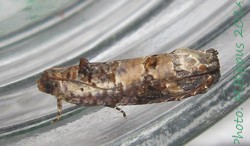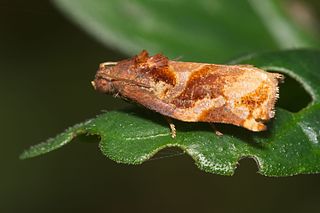
Dudua aprobola, the mango flower webworm or litchi leaf roller, is a moth of the family Tortricidae. The species was first described by Edward Meyrick in 1886. It is a pest on several economically important crops.

Homona coffearia, the tea tortrix or camellia tortrix, is a moth of the family Tortricidae. The species was first described by Nietner in 1861. It is widely distributed in the Oriental region.

Homona mermerodes is a species of moth of the family Tortricidae first described by Edward Meyrick in 1910. It was described from the Solomon Islands, but is also found in Australia (Queensland), New Guinea and Seram. The habitat consists of bamboo, secondary forests and alluvial forests.
Homona baolocana is a species of moth of the family Tortricidae. It is found in Vietnam.
Homona parvanima is a species of moth of the family Tortricidae. It is found in Vietnam.
Homona polystriana is a species of moth of the family Tortricidae. It is found in Vietnam.

Homona magnanima, the Oriental tea tortrix moth, is a species of moth of the family Tortricidae. It is found in Japan, Taiwan, China and Vietnam.
Homona aestivana is a species of moth of the family Tortricidae first described by Francis Walker in 1866. It is found in the Philippines, Australia (Queensland), New Guinea and Indonesia.
Homona salaconis is a species of moth of the family Tortricidae first described by Edward Meyrick in 1912. It is found in the Philippines, Seram, Sumatra, Sulawesi and Dutch New Guinea. The habitat consists of cultivated areas and lowland forests.
Homona obtusuncus is a species of moth of the family Tortricidae first described by Józef Razowski in 2013. It is found on Seram Island in Indonesia. The habitat consists of lower montane forests.
Homona privigena is a species of moth of the family Tortricidae first described by Józef Razowski in 2013. It is found on Seram Island in Indonesia. The habitat consists of upper montane forests.
Homona blaiki is a species of moth of the family Tortricidae first described by Józef Razowski in 2013. It is found on Seram and in New Caledonia. The habitat consists of alluvial forests, Eucalyptus forests, bamboo and secondary forests.
Homona bakeri is a species of moth of the family Tortricidae. It is found in the Philippines on the island of Luzon.
Homona eductana is a species of moth of the family Tortricidae. It is found in India, Thailand, Malaysia, Singapore and China.
Homona encausta is a species of moth of the family Tortricidae first described by Edward Meyrick in 1907. It is found in Sri Lanka, Luzon in the Philippines and Vietnam.
Homona fistulata is a species of moth of the family Tortricidae. It is found in Australia, where it has been recorded from Queensland.

Homona tabescens is a species of moth of the family Tortricidae. It is found in south-east Asia, where it has been recorded from Java, Sabah, China, Thailand, Malaysia, New Guinea and Vietnam.
Macaranga novoguineensis is a species of tree in the Euphorbiaceae family. It is native to New Britain and New Guinea. It is a late succession plant, and supports a variety of insect herbivores, including caterpillars from the moth Homona mermerodes.
Ficus bernaysii is a lowland rainforest tree in the family Moraceae, native to an area from New Guinea to the Solomon Islands. It is dioecious, and grows cauliflorous fruit. It is fed on by a wide range of animals.
A tree in the Moraceae family, Ficus phaeosyce grows in eastern New Guinea, endemic to the nation of Papua Niugini. It is a shade tolerant understorey species, locally very abundant. A range of insect herbivores feed on the plant.




